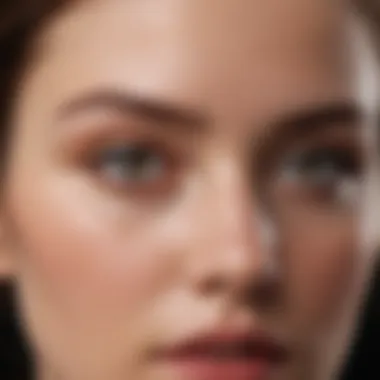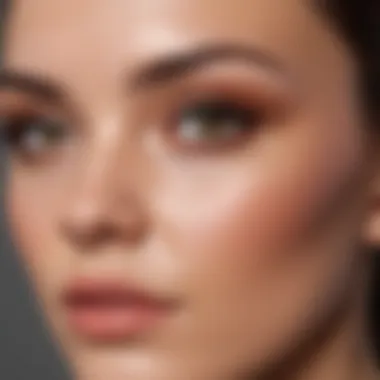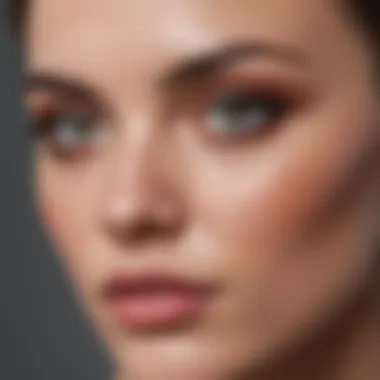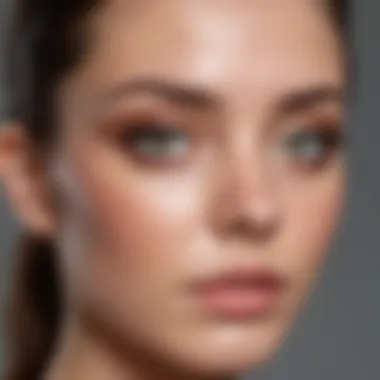Mastering Under Eye Cover Up Makeup Techniques


Intro
Makeup has evolved into a vital tool for self-expression, allowing individuals to enhance their natural beauty while addressing certain imperfections. One common concern in this area is under eye treatment. Dark circles and puffiness can detract from an otherwise polished appearance. This article aims to dissect the complexities of under eye cover up makeup systematically, providing insights that can benefit both novices and proficient makeup enthusiasts.
The importance of applying under eye makeup cannot be overstated. It serves not only as a cosmetic solution but also as an avenue for boosting confidence. Therefore, understanding the intricacies of product selection and application techniques is essential.
Beyond its function, makeup should blend seamlessly for a natural finish. Various techniques exist for achieving such results. Mistakes during application can lead to undesired effects, which is why this article will outline common errors and methods for correcting them.
In the sections that follow, we will explore current fashion trends in under eye makeup, essential beauty tips, and a thoughtful analysis of trending products to guide your selection process.
Understanding Under Eye Concealment
Under eye concealment is a fundamental aspect of makeup application that many find essential. It plays a critical role in enhancing one's appearance by addressing common concerns such as dark circles, puffiness, and fine lines. Each of these issues can impact the overall look, making the eye area appear tired or aged. Thus, understanding how to effectively conceal these imperfections can significantly boost confidence and create a more vibrant appearance.
The Role of Concealer in Makeup
Concealer serves as a tool for correcting imperfections on the skin. Unlike foundation, which provides overall coverage, concealer focuses on specific areas needing extra attention. The under eye area requires special consideration due to its delicate skin and vulnerability to various imperfections. A well-chosen concealer can not only hide flaws but also brighten the gaze and create a more awake appearance.
Common Concerns Addressed by Concealers
Concealers are favored for their ability to tackle common skin issues that arise in the under eye area. Here's a closer look at the specific concerns addressed by these products:
Dark Circles
Dark circles often signal fatigue or lack of sleep. They manifest as shadows beneath the eyes and can detract from one’s overall appearance. This particular concern is common across age groups and can stem from various factors, including genetics, lifestyle, and aging. The shadowy effect of dark circles can create a tired look, which many seek to conceal.
When discussing dark circles, it is vital to note the characteristic blue or purple hues. This is a key feature that informs product choice, as specific concealers with peach or orange undertones can neutralize these shades, creating a more balanced appearance. The right concealment can significantly rejuvenate one’s look, offering a youthful vibrance that benefits any makeup routine.
Puffiness
Puffiness, or swelling under the eyes, is another common issue. This can occur due to various reasons, such as lack of sleep, allergies, or diet. The key characteristic of puffiness is its tendency to make one’s eyes look heavy or swollen, which can be unflattering. A major advantage of targeted products is their ability to provide a lifting effect, helping to firm the skin while concealing the issue.
Products designed for puffiness often contain ingredients like caffeine, which help reduce swelling. Using a suitable concealer for puffiness not only covers the issue but can also offer some relief from the underlying causes. This combination of coverage and treatment distinguishes it as a popular choice for many makeup enthusiasts.
Fine Lines
Fine lines around the eyes are indicative of aging, and they commonly prompt concerns about sagging skin. These lines can create shadows that add to the appearance of dark circles. A defining feature of fine lines is their potential to disrupt the smooth application of makeup.
Choosing the right concealer for fine lines is crucial. Many formulations are specifically designed to hydrate and plump the under-eye area, which helps in minimizing the look of these lines. Proper concealment of fine lines not only smooths the appearance but also contributes to creating a youthful look. Thus, this makes it a beneficial aspect of a comprehensive under eye makeup strategy.
"Effective under eye concealment can dramatically transform one's appearance and boost self-esteem."
In summary, understanding these specific concerns is foundational for anyone interested in mastering under eye concealment. The implications of dark circles, puffiness, and fine lines are critical. Here, concealer acts as both a corrective and enhancing tool, making it a vital component of effective makeup application.
Selecting the Right Under Eye Concealer
Selecting the appropriate under eye concealer is crucial for achieving a polished appearance. The under eye area is delicate and often prone to issues such as dark circles, puffiness, and fine lines. Thus, understanding the importance of choosing the right concealer is vital to ensure both coverage and comfort. Using the wrong product can lead to an unnatural look or can even exacerbate existing concerns. Hence, this section focuses on identifying various concealer types, formulations, and shade matching to enhance the overall makeup application.
Types of Concealers and Their Formulations


Different types of concealers are formulated to cater to specific needs, and knowing your options can significantly elevate your makeup game.
Liquid Concealers
Liquid concealers are often favored for their blendability. They provide a lightweight feel, making them suitable for the under eye region, where heavy products can settle into fine lines. A key characteristic of liquid concealers is their versatility; they can range from sheer to full coverage. This flexibility is beneficial for those who want to adjust their look throughout the day.
However, while they are easy to apply, liquid concealers can sometimes fall short in terms of longevity. They may require touch-ups, particularly in warmer climates.
Cream Concealers
Cream concealers offer a thicker consistency compared to their liquid counterparts, making them ideal for providing robust coverage. They are excellent for hiding darker circles or any discoloration. A significant advantage of cream concealers is their ability to adhere well to the skin, which can enhance the wear time. However, they may not always blend as seamlessly and can feel heavier, especially if applied in excess.
Stick Concealers
Stick concealers are known for their convenience and precision in application. The solid form allows for targeted coverage, making them effective for spot concealing, not only under the eyes but also on blemishes. Their creamy texture provides decent coverage without feeling overly heavy. However, the challenge with stick concealers lies in blending. They may need more effort to ensure a natural finish beneath the eyes, and they can occasionally emphasize dryness if the skin is not well-prepped.
Opacity Levels
The opacity level of a concealer is paramount in determining how much coverage it offers. Ranging from sheer to full opacity, each level serves different purposes. Sheer concealers can soften the appearance of dark circles while full opacity products aim for complete coverage. Choosing the right opacity is influenced by individual skin concerns and desired outcomes. For daily wear, opting for a sheer or medium opacity may result in a more natural finish; however, for special occasions, full opacity may be preferred to mask any imperfections effectively.
Choosing the Correct Shade
Selecting the right shade is not just about picking a color that looks good; it’s about understanding how those shades interact with your skin tone. This step is crucial for achieving an undetectable cover-up.
Understanding Undertones
The undertone of your skin significantly impacts how concealer appears once applied. Undertones can be classified as cool, warm, or neutral. Identifying your undertones can help in selecting a concealer that blends seamlessly. A concealer with the correct undertone can brighten the area without looking overly stark or ashy. Failure to consider undertones can lead to a concealer appearing incongruent with the skin, resulting in an unnatural look.
Testing Shades
Testing shades in natural light is key. Swatch a few shades along the jawline to see how they adapt to the lighting and skin tone. A shade that matches your under eye area may differ from what works on the rest of your face. Adjusting for any dark circles is essential. Shadows may require one to two shades lighter than one’s natural color for adequate concealment, but testing ensures that the correct level of brightness is achieved without mismatch.
Seasonal Considerations
Skin tone can fluctuate with the seasons. In winter, the skin may take on a paler hue due to lesser sun exposure, compared to summer when tanning may occur. Taking these seasonal changes into account is critical for maintaining a consistent concealer look throughout the year. Using a different shade or adjusting the formulation to accommodate seasonal variations can lead to lasting results, avoiding an incongruent appearance throughout the changing months.
Techniques for Applying Under Eye Concealer
Applying the right techniques for under eye concealer is crucial for achieving a polished and natural look. This is not just about hiding flaws; it is about enhancing the overall appearance by addressing specific concerns like dark circles, puffiness, and fine lines. Understanding these techniques allows for a more effective application, ensuring that the concealer blends seamlessly with the skin. A well-executed application can make a significant difference in how youthful and fresh the face appears.
Preparation of the Under Eye Area
Hydration
Hydration of the under eye area prepares the skin for concealer application. Well-hydrated skin tends to show fewer wrinkles and, therefore, provides a smoother base for makeup. A key characteristic of hydration is its ability to plump the skin, reducing the appearance of fine lines. This makes it a beneficial choice for anyone looking to achieve a flawless finish. In this article, the unique feature of hydration comes from its potential to improve skin texture, which can ultimately enhance the effectiveness of concealer. However, one must ensure that the hydrating product is suitable for the delicate under-eye area to avoid any adverse effects.
Brightening Products
Brightening products play a vital role in making the under eye area appear more awake. These products often contain light-reflecting qualities that can significantly reduce the appearance of dark circles. Their key characteristic is the ability to illuminate the skin, making it a popular choice among makeup enthusiasts. Brightening products also typically come in various formulations, such as creams or gels, which can suit different skin types. However, one must be cautious. Some brightening agents can be too harsh for sensitive skin, leading to irritation, so it’s essential to choose wisely.
Application Methods


Using Fingers
Utilizing fingers for application allows for a warm touch that can help in blending the product into the skin. The body heat can make the concealer more pliable, which allows for a more precise application. This method is particularly beneficial for those wanting a lightweight application. However, while using fingers can offer great control, it may not always deliver an even finish, especially if not blended properly.
Brush Techniques
Brush techniques provide a more professional approach to concealing under eye imperfections. The right brush will allow for a smooth and even application, which is essential for blending. A flat concealer brush can cover large areas, while a smaller brush helps with precision. This method can be very effective for thin layers, but one downside is the potential for brush strokes, which can lead to an uneven appearance if not blended adequately.
Sponge Application
Sponge application has become increasingly popular due to its ability to create a seamless finish. Damp sponges can absorb excess product, leaving just the right amount on the skin. This technique is beneficial as it provides a light, natural finish. However, sponges require cleaning to maintain hygiene, and improper usage can lead to product waste or streaks.
Blending for a Flawless Finish
Patting Techniques
Patting techniques emphasize a soft touch that can effectively manipulate product into the skin. This method is advantageous as it helps avoid disturbing the under eye area, thus maintaining the integrity of the skin and other applied products. The main feature of patting is the gentle approach, leading to minimal pulling of the skin. However, it can take more time and patience to achieve the desired look compared to other methods.
Avoiding Harsh Lines
Avoiding harsh lines is crucial for creating a natural appearance. A well-blended concealer should not be noticeable and should seamlessly blend into the surrounding skin. This characteristic of a smooth finish is vital, as harsh lines can draw attention to imperfections rather than concealing them. To achieve this, using multiple techniques, such as buffing or applying slight pressure while blending, may be necessary. Failure to avoid harsh lines can result in an unfinished look that negates the entire purpose of applying concealer.
Setting and Maintaining Concealer
Setting and maintaining under eye concealer is a crucial step in achieving a polished and enduring makeup look. The delicate skin around the eyes is prone to creasing, fading, and excessive shine. Therefore, it is vital to use the right products and techniques to ensure that the concealer remains intact and looking fresh throughout the day. Proper setting also helps in locking in the concealer, allowing it to stay in its intended place while preventing it from drawing attention to any imperfections. The ultimate goal is to create a smooth, luminous appearance that withstands various environmental factors, such as humidity and temperature changes.
Choosing the Right Setting Products
Translucent Powders
Translucent powders play an important role in setting under eye concealers. They provide a lightweight finish that allows the skin's natural tone to shine through while preventing the concealer from settling into fine lines. The key characteristic of translucent powders is their fine texture, which helps to absorb excess oil and mattify the area under the eyes. This is a popular choice among makeup enthusiasts because it provides a seamless finish without adding any color.
The unique feature of translucent powders is that they come in various formulations, such as loose and pressed options. They typically contain ingredients like silica or talc, which help to create a soft-focus effect. The advantages include longevity, as they significantly extend the wear of the concealer. However, it is critical to apply them sparingly to avoid a chalky appearance, especially on dry skin.
Setting Sprays
Setting sprays have gained popularity for their ability to lock in makeup while providing a refreshing finish. These sprays are designed to create a protective layer over the makeup, including the under eye concealer. What sets setting sprays apart is their versatility; they come in various formulations tailored for different skin types, such as oily, dry, or combination.
A key characteristic of setting sprays is their ability to not only set the makeup but also enhance the overall appearance. They can reduce the powdery look by providing a natural dewy finish. This product can be especially beneficial for individuals who prefer luminous skin. One unique feature of setting sprays is their ease of application—simply spritz the product evenly across the face. The advantages include hydration and improved longevity, although some formulations may not be suitable for sensitive skin and could cause irritation.
Application Techniques for Longevity
Light Dusting Method
The light dusting method is a technique that emphasizes a minimalistic approach to applying setting powder. This method involves using a soft brush to apply a sheer layer of translucent powder under the eyes. The key characteristic of this technique is its ability to avoid excess product build-up, which can lead to heaviness or caking.
Using this method allows for a natural finish while ensuring that the concealer remains secure. A unique aspect is that it enables flexibility—if more coverage is needed, one can easily add more powder without compromising the overall look. This makes it a beneficial approach, particularly for those with normal or combination skin, while being advised against for dry skin types.
Avoiding Caking


Avoiding caking is a crucial aspect of setting under eye concealer. Caking occurs when too much product accumulates in the fine lines, creating an unflattering appearance. This can be particularly noticeable under the eyes, which can already display signs of aging or fatigue.
The key to avoiding caking lies in the application technique and product choice. Utilizing the right amount of concealer and setting products ensures that there is no excess. A unique feature here is to embrace the less-is-more philosophy; applying thin layers of both concealer and powder often yields the best results. The advantages of avoiding caking include ensuring a smoother, more youthful appearance, while the main disadvantage is that it requires a careful and controlled approach to application.
“The best results come from a balanced approach. Too much product can lead to caking, while too little can leave the under eye area unprotected.”
By understanding the importance of setting and maintaining concealer, along with the right products and techniques, one can achieve a lasting under eye look that enhances beauty without compromise.
Common Mistakes and How to Avoid Them
Understanding the common mistakes in under eye cover up makeup is crucial for achieving a polished and natural look. Many women often fall into the trap of poor application, which can result in uneven textures and more visible imperfections. Addressing these mistakes not only enhances one's makeup application but can also significantly improve overall appearance and self-confidence.
Over-Using Product
One of the most prevalent errors is the over-application of concealer. Applying too much product can lead to a cakey and heavy appearance. The under eye area is delicate and prone to creasing, so less is often more. A small amount of concealer applied in thin layers can better cover imperfections without overwhelming the skin.
To avoid this mistake, consider the following tips:
- Start with a minimal amount and gradually build up as needed.
- Use a damp sponge or your fingertip for gentle blending, avoiding the temptation to pile on more product.
- Focus on areas where coverage is truly needed, instead of applying concealer all over the under eye area.
Choosing the Wrong Formula
Another critical mistake is selecting a concealer that doesn’t suit individual skin type or concerns. For instance, a thicker formula may accentuate fine lines, while a sheer formula might not provide enough coverage for dark circles. It is important to consider both skin’s texture and the specific issues you aim to correct.
When selecting a formula, keep these points in mind:
- Recognize your skin type: For oily skin, opt for matte finish concealers, while those with dry skin may prefer hydrating formulations.
- Assess your needs: If you have prominent dark circles, choose a thicker or more pigmented product.
- Trial and error: Testing different types on your skin can determine which formula works best for you.
Neglecting Skin Preparation
The foundation of effective concealer application starts with proper skin care. Neglecting the preparation of the under eye area can lead to uneven application and an overall lackluster finish. Hydration is key; the under eye skin can easily become dry and flaky, making it difficult for concealers to sit well on the skin.
To avoid this pitfall, adhere to these guidelines:
- Always moisturize the under eye area with an appropriate cream to keep skin smooth and supple.
- Consider using a brightening eye cream to enhance radiance before applying concealer.
- Allow products to absorb properly before layering concealer – this means waiting a few minutes after applying your moisturizer.
Important Note: Careful attention to these common mistakes will enhance your technique and lead to a more polished overall appearance. Taking the time to adjust your application method can make a significant difference in your makeup routine.
By being mindful of these common pitfalls, you can master the art of under eye cover up makeup, yielding impressive results that illuminate your natural beauty.
Finale and Final Thoughts
The importance of personal technique in the application process cannot be understated. Each individual's skin type, tone, and preference influence the best approach to under eye makeup. As discussed, factors like formulation type and the specific product shade should align with one’s unique features for optimal results.
The Importance of Personal Technique
Individual technique plays a vital role in makeup application. Different skin types respond uniquely to various products, making it critical to adapt methods accordingly. Some may find that a damp sponge provides a smoother finish, while others might prefer using fingers for better control. Observing the results from different approaches can lead to significant improvements in application skills. Additionally, observing how varying environmental factors, like humidity, impact makeup wear can help refine techniques further.
Therefore, cultivating a personalized process ensures that the end result looks seamless and natural. Emphasizing personal technique as a core component not only enhances application efficiency but also builds a connection between the user and their beauty routine.
Encouragement for Experimentation
There is a valuable lesson in embracing experimentation with under eye cover up makeup. Beauty is subjective; what works for one person may not work for another. Trying out various brands, shades, and application methods can unveil hidden potential that was previously overlooked.
For example, experimenting with different formulations can lead to finding the perfect match between skin consistency and color. Venturing beyond familiar products and incorporating formulas like creamy concealers or even color correctors can bring about surprising results. Creative approaches like layering products or mixing formulas for improved opacity are worth exploring.



